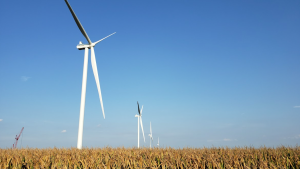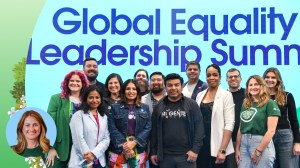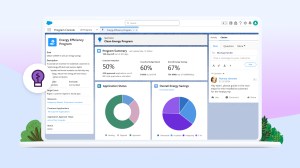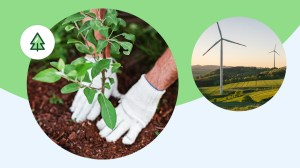With over 200 companies committed to reaching 100% renewable energy (RE), voluntary corporate purchasing of renewable energy is playing an increasingly important role in the clean energy transition. How and where that renewable energy is deployed can drive radically different outcomes — maximizing positive impact for a range of stakeholders, or limiting benefits to just a few. How can corporate purchasers of renewable energy ensure the clean energy transition meets its full potential for improving the state of the world?
Last week, Salesforce published a Renewable Energy white paper that provides a starting framework and expert third-party guidance on how to maximize the positive impacts of renewable energy purchases and minimize the negative impacts. We believe that moving towards a holistic evaluation of renewable energy projects is a critical step for the industry, and we’re excited to share with others what we’ve learned over the years.
In this interview, leaders of Salesforce’s Clean Energy and Carbon Programs, Megan Lorenzen and Max Scher, discuss Salesforce’s commitment to reaching 100% RE, why it’s important to transparently share our clean energy priorities, and how a holistic evaluation of RE projects can help ensure the energy transition meets its true potential for improving the state of the world.
Q: Max, what is Salesforce’s goal with the company’s RE target?
In 2013 we made our first public commitment to reach 100% RE. For Salesforce, that means purchasing renewable energy and certificates equivalent to the amount of power we use in our global operations every year. Doing so is just one of the steps we’re taking to tackle our electricity related emissions, along with using less energy, and advocating for policy changes that set us all on course to clean and renewable energy powering the world around the clock.
Today, just seven years since our public commitment, we procured electricity from new renewable energy resources equivalent to 63% of what we use globally, and are on track to reach 100% RE by 2022
Max Scher, Head of Clean Energy and Carbon Programs, Salesforce
Achieving this the impactful way means thinking about deliberate, lasting, long-term grid transformation. That’s why Salesforce focuses on trying to purchase renewable energy in ways that adds new renewable energy to the grid, avoids and reduces the greatest possible emissions, and blazes a trail for others to follow. Today, just seven years since our public commitment, we procured electricity from new renewable energy resources equivalent to 63% of what we use globally, and are on track to reach 100% RE by 2022.
Q: Megan, Can you tell us a little more about how Salesforce’s RE procurement process has evolved over the years?
In the beginning of our journey, our RE purchases focused mainly on transactional elements like the quantity and cost of what we’re purchasing to reach our 100% RE target. Not surprisingly, we quickly learned that not all RE is created equal—two projects with identical transactional details can have enormously different impacts. Some RE projects displace more fossil fuels than others, some are built at the cost of critical habitat for plants and animals, and others provide critical support for their local community.
For us, purchasing RE is about more than adding new megawatts of renewable energy to the grid. It’s about improving the state of the world
Megan Lorenzen, Sustainability Manager, Salesforce
For us, purchasing RE is about more than adding new megawatts of renewable energy to the grid. It’s about improving the state of the world, which includes reducing emissions, and so much more. So, we began to ask ourselves a simple question. What does “the best” renewable energy project look like to us? How do we make sure the projects we support are having the greatest positive impacts, and least negative ones?
To help us answer those questions, we developed a procurement matrix to evaluate RE projects against a number of criteria important to Salesforce.
Q: A procurement Matrix? Megan, can you tell us how it is being used today both at Salesforce and with your partners?
The Procurement Matrix is really a sensing mechanism that helps us identify and select the best projects to purchase RE from. When we’re looking to make a purchase we put out a request for proposal, which project developers respond to. We use the matrix to score those responses across transactional, economic, environmental and social criteria. Each criteria is weighted according to Salesforce’s own prioritization. While we inevitably still have to make tradeoffs between these criteria, the step of asking developers about each criteria sends an important signal to the market. We’ve even successfully influenced developers to address shortcomings they hadn’t prioritized beforehand.
The more buyers and investors ask these questions, the stronger the signal to the market. Hopefully, with a strong enough signal, the industry as a whole will shift, and we’ll eventually have to make fewer tradeoffs.
With this in mind, we’ve asked the Renewable Energy Buyers Alliance (REBA), an alliance of clean energy buyers, service providers and NGOs working to unlock the marketplace for renewable energy buyers and accelerate the transition to a zero-carbon energy future, to continue leading the entire buyer community into the next phase of this journey.
We are thrilled to announce that we plan to provide nearly a quarter of a million dollars in grant funding in support of the REBA Institute as it carries this work forward.
Q. Max, you released a white paper last week sharing your matrix and Salesforce’s approach to renewable energy procurement. Can you tell us more about what you’ve included in the paper?
As Megan shared, not all projects are created equal. Companies choosing to purchase renewable energy are playing an increasingly important role in the clean energy transition and they need to be able to evaluate all aspects of a renewable energy project before purchasing.
Companies choosing to purchase renewable energy are playing an increasingly important role in the clean energy transition and they need to be able to evaluate all aspects of a renewable energy project before purchasing.
Max Scher, Head of Clean Energy and Carbon Programs, Salesforce
In the paper, we gathered insight from subject matter experts who shared good practices and guidance across a number of environmental and social criteria, and created actionable guidance that RE buyers like us can use to evaluate projects. Criteria such as – avoided emissions, land use, air quality and community engagement.
This is just one step on this industry’s journey. We know that what we included here is incomplete and imperfect, but it’s a start. There are more criteria to add, and more views on existing criteria to surface. The most important thing is that we start to recognize the amazing impact RE can have and keep working to emphasize it.
Q: Megan, can you provide an example of this procurement matrix in use?
Today we have announced the company’s first international renewable energy agreement, with X-ELIO’s Blue Grass solar farm, located in the Western Downs region of Queensland. Salesforce has contracted with 25% of the 200MW project which in total is expected to generate enough energy to power the equivalent of 80,000 Queensland homes, and save more than 320,000 tonnes of CO2 emissions each year.
The Blue Grass solar farm is an excellent example of how the matrix can help identify projects that are better at improving the state of the world. While there will inevitably be tradeoffs between criteria, this project checked a number of boxes, including: high avoided emissions, ideal siting and strong community engagement.
By measuring the avoided emission potential of different renewable energy projects, we were able to identify projects that are particularly effective at reducing emissions, helping combat climate change. Blue Grass has the highest avoided emissions rate of any project in Salesforce’s portfolio, over two times that of a comparable project in California.
The project is sited on land with low ecological value, avoiding sensitive vegetation and wildlife habitats.
And in addition to creating 400 construction jobs, X-ELIO is dedicating a percentage of the annual gross income of the project to a Community Support and Benefit Sharing Program, which will support local community projects in areas such as education and community renewable projects
Q: Max, What are you hoping to accomplish with sharing the approach in the white paper and where will it go from here with the new REBA grant?
Companies have a rapidly increasing influence on the RE market as a whole. By making it clear that these other environmental and social criteria matter, we can improve that market, and the world. The goal of this paper is to share our learnings and our approach with the entire renewable energy community. Our hope is that others can use and build upon this, and together we can ensure the energy transition meets its true potential for improving the state of the world.
As Megan mentioned, with the new grant funding to the REBA Institute, it will take this forward in a new workstream called “Beyond the Megawatt”, gathering feedback and input from large energy buyers, NGOs, and scientists to expand this resource for the entire clean energy community.
Q: Wow – a new workstream? Max, can you share a little more about REBA and why you have confided in them to take this important work forward?
REBA is one of the most successful NGO collaborations accelerating the renewable energy market, and is uniquely positioned to tap into the expansive expertise of the renewable energy community to build out a robust tool for all buyers to use when selecting renewable energy projects. Many of the experts featured in the paper are ones we met at REBA events.
For our part, we will continue to develop criteria with the REBA community, including funding research on critical topics.
Q: Megan, you mentioned Salesforce is on track to reach 100% RE by 2022. That is right around the corner. What can you say about your progress?
We are excited to be on the right track to reach our interim goal of 100% RE. However, it’s important to remember that our ultimate goal is a future in which clean and renewable energy is powering the world around the clock. This will take a suite of actions, including trillions of dollars in investment, policy and regulatory changes, and much more. That is why another critical component of our climate action work is using our voice to advocate for policies that set geographies on a path to a just transition to a low-carbon economy.
We believe that being transparent with our work not only holds ourselves accountable, but helps others on their own journey. Stay tuned for more detail on our policy journey–because we know we can’t catalyze global systemic change alone.



















